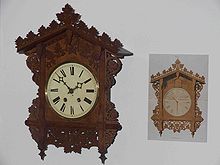Furtwangen watchmaking school
The Furtwanger watchmaking school is the oldest such school in Germany. She contributed significantly to the development of the watch industry in the Black Forest and continues to train watchmakers to this day .
founding
In 1850 the government of the Grand Duchy of Baden wanted to support the “poor house” in the high Black Forest . Since there were many farmers and craftsmen in the Black Forest around Furtwangen who worked as watchmakers during the long winters , better training was to improve their sales opportunities on the market.
Commissioned by the government in Karlsruhe, the young engineer Robert Gerwig founded the first German watchmaking school in Furtwangen in 1850 .
The watch museum is created
After only two years, Robert Gerwig founded a teaching collection with clocks at the school, for which he collected clocks in an appeal throughout the region. This collection, which was soon made accessible to the public, then developed into the German Clock Museum , which today is the largest German clock collection. The watch museum is part of the Furtwangen University and thus a direct successor to the watchmaking school.
The cuckoo clock
The Black Forest cuckoo clock in its current form also comes from the watchmaking school . The first cuckoo clocks were made in the Black Forest since the middle of the 18th century. In order to increase the sales of clocks in and around Furtwangen, headmaster Robert Gerwig organized a competition in 1850: he called on the "patriotic artists" in the whole of the Grand Duchy of Baden to come up with a design for a new clock case for the cuckoo clock.
Architect Friedrich Eisenlohr then submitted a design that was based on his plans for the station keeper's house of the Badische Staatsbahn : The so-called train house clock became a hit and the basis for all cuckoo clocks of the last 150 years: the house remained almost unchanged, only has changed the decor. Furtwangen and the surrounding areas have become the center for the production of the "original Black Forest cuckoo clock" through the watchmaking school to this day.
Further development
With some ups and downs, the school continued to develop. It was even closed for a couple of years as the watchmaking situation had improved. At the end of the 19th century, in addition to watchmaking, electromechanics and precision mechanics were also taught. In the 1920s, radio technology was added. The school thus made a significant contribution to the fact that the industry in Furtwangen could develop further with appropriately qualified skilled workers.
Division of the school
After the Second World War, the watchmaking school was divided into two branches. Both branches can thus be directly traced back to Robert Gerwig's watchmaking school in 1850.
The university
One branch was the engineering school. Precision mechanics naturally played an important role here, coming from watchmaking. The engineering school then developed into the Furtwangen University of Applied Sciences , which is now called the Furtwangen University (HFU).
The vocational school
The second branch was a vocational school, which then developed into a vocational school center, the Robert-Gerwig-Schule. Here you will find commercial and economic school branches or a technical and a business high school. But still the vocational school, where you can train to become a watchmaker with full-time lessons in around three years. Further apprenticeships are precision mechanic , system electronics technician and technical product designer .
Web links
- Search for the Furtwangen watchmaking school in the German Digital Library
- Search for the Furtwangen watchmaking school in the SPK digital portal of the Prussian Cultural Heritage Foundation
- Robert Gerwig School with a watchmaking school
- The German Clock Museum
- The Furtwangen University
Coordinates: 48 ° 2 ′ 50.2 " N , 8 ° 12 ′ 47.6" E
